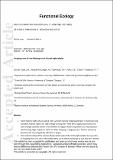Files in this item
Foraging rates of ram-filtering North Atlantic right whales
Item metadata
| dc.contributor.author | van der Hoop, Julie Marie | |
| dc.contributor.author | Nousek-McGregor, Anna E. | |
| dc.contributor.author | Nowacek, Douglas P. | |
| dc.contributor.author | Parks, Susan E. | |
| dc.contributor.author | Tyack, Peter | |
| dc.contributor.author | Madsen, Peter Teglberg | |
| dc.date.accessioned | 2020-06-09T23:34:54Z | |
| dc.date.available | 2020-06-09T23:34:54Z | |
| dc.date.issued | 2019-06-10 | |
| dc.identifier | 258981013 | |
| dc.identifier | 95f7cc84-6cc3-4766-a126-7c1136b2ba27 | |
| dc.identifier | 85067385822 | |
| dc.identifier | 000509349600011 | |
| dc.identifier.citation | van der Hoop , J M , Nousek-McGregor , A E , Nowacek , D P , Parks , S E , Tyack , P & Madsen , P T 2019 , ' Foraging rates of ram-filtering North Atlantic right whales ' , Functional Ecology , vol. Early View . https://doi.org/10.1111/1365-2435.13357 | en |
| dc.identifier.issn | 0269-8463 | |
| dc.identifier.other | RIS: urn:50E241258B2EB4C98EC79A28FD9143C9 | |
| dc.identifier.other | ORCID: /0000-0002-8409-4790/work/60887829 | |
| dc.identifier.uri | https://hdl.handle.net/10023/20061 | |
| dc.description | Tag data were collected in the U.S. and Canada under NMFS permit #14791. JVDH received funding from the European Union’s Horizon 2020 research and innovation programme under the Marie Skłodowska-Curie Individual Fellowship grant agreement No 706867. PLT acknowledges the support of the MASTS pooling initiative (The Marine Alliance for Science and Technology for Scotland) in the completion of this study. MASTS is funded by the Scottish Funding Council (grant reference HR09011) and contributing institutions. | en |
| dc.description.abstract | 1. North Atlantic right whales spend their summer months foraging primarily in American and Canadian Atlantic waters on high‐energy‐density prey. Here, they rapidly accumulate and store energy obtained within a few months to support future migrations and reproduction while fasting. High drag from their ram‐filter foraging strategy places a limit on what prey densities will be energetically efficient to target. 2. Our understanding of the volume of prey‐laden water filtered by right whales during a dive or foraging bout, and what information they use to decide to forage or not, has been limited by the difficulties of measuring when they feed at depth, how fast they swim during continuous ram filtration and how often they might swallow accumulated prey. 3. We used 10 DTAG deployments from right whales in the Bay of Fundy, Canada, to quantify swimming speeds and estimate the volume of prey‐laden water filtered per dive. We used the tag's inertial sensors to evaluate the timing of frequent biomechanical changes that likely indicate the truncation of continuous filtration, and whether the number or timing of these fluking bouts relates to longer feeding dives or other foraging decisions. 4. During foraging dives, right whales descended at 1.4 (±0.2 SD) m/s and slowed to swim at 1.1 (±0.3) m/s while filtering. We found consistent pauses in the fluking behaviour of foraging right whales, every 56 (±22) s. Whales filtered on average 78 (±30) m3 of water per fluking bout and on average 673 (±201) m3 per dive. 5. Right whales filter large volumes of water at low speeds with a high duty cycle, but require sufficiently high prey energy densities to compensate for a high‐drag foraging strategy. Closely related bowhead whales have a larger gape but swim more slowly, filtering greater volumes with lower drag. Our findings highlight that right whales acquire their energy in a relatively short period of intense foraging; even moderate changes in their feeding behaviour or their prey energy density are likely to negatively impact their yearly energy budgets and therefore reduce fitness substantially. | |
| dc.format.extent | 18 | |
| dc.format.extent | 1549422 | |
| dc.language.iso | eng | |
| dc.relation.ispartof | Functional Ecology | en |
| dc.subject | Biomechanics | en |
| dc.subject | Drag | en |
| dc.subject | Filter-feeding | en |
| dc.subject | Foraging | en |
| dc.subject | Ram filtration | en |
| dc.subject | Right whale | en |
| dc.subject | GC Oceanography | en |
| dc.subject | QH301 Biology | en |
| dc.subject | DAS | en |
| dc.subject.lcc | GC | en |
| dc.subject.lcc | QH301 | en |
| dc.title | Foraging rates of ram-filtering North Atlantic right whales | en |
| dc.type | Journal article | en |
| dc.contributor.institution | University of St Andrews. Centre for Social Learning & Cognitive Evolution | en |
| dc.contributor.institution | University of St Andrews. Scottish Oceans Institute | en |
| dc.contributor.institution | University of St Andrews. Bioacoustics group | en |
| dc.contributor.institution | University of St Andrews. Sound Tags Group | en |
| dc.contributor.institution | University of St Andrews. Sea Mammal Research Unit | en |
| dc.contributor.institution | University of St Andrews. Marine Alliance for Science & Technology Scotland | en |
| dc.contributor.institution | University of St Andrews. School of Biology | en |
| dc.identifier.doi | 10.1111/1365-2435.13357 | |
| dc.description.status | Peer reviewed | en |
| dc.date.embargoedUntil | 2020-06-10 |
This item appears in the following Collection(s)
Items in the St Andrews Research Repository are protected by copyright, with all rights reserved, unless otherwise indicated.

